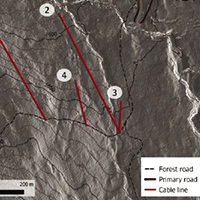Energy efficiency of a hybrid cable yarding system: A case study in the North-Eastern Italian Alps under real working conditions

Published:30 September 2021
Abstract Views: 1249
PDF: 586
HTML: 5
HTML: 5
Publisher's note
All claims expressed in this article are solely those of the authors and do not necessarily represent those of their affiliated organizations, or those of the publisher, the editors and the reviewers. Any product that may be evaluated in this article or claim that may be made by its manufacturer is not guaranteed or endorsed by the publisher.
All claims expressed in this article are solely those of the authors and do not necessarily represent those of their affiliated organizations, or those of the publisher, the editors and the reviewers. Any product that may be evaluated in this article or claim that may be made by its manufacturer is not guaranteed or endorsed by the publisher.
Similar Articles
- Juan Ãngel Mintegui Aguirre, José Carlos Robredo Sánchez, Carlos de Gonzalo Aranoa, Pablo Huelin Rueda, Jorge Fallas, Felipe Cisneros, Pedro Cisneros, Adriana Urciuolo, Rodolfo Iturraspe, Forest use strategies in watershed management and restoration: application to three small mountain watersheds in Latin America , Journal of Agricultural Engineering: Vol. 45 No. 1 (2014)
- Francesco Bettella, Tamara Michelini, Vincenzo D'Agostino, Gian Battista Bischetti, The ability of tree stems to intercept debris flows in forested fan areas: A laboratory modelling study , Journal of Agricultural Engineering: Vol. 49 No. 1 (2018)
- Raffaele Cavalli, Stefano Grigolato, Marco Pellegrini, The evolution of a mountain road network from its original use during the First World War to meeting today’s forestry needs: current management , Journal of Agricultural Engineering: Vol. 43 No. 3 (2012)
- Pasquale Dal Sasso, Giuseppe Ruggiero, Maria Antonella Ottolino, Giuseppe Verdiani, The role of agroforestry areas of the province of Bari in the absortion of carbon dioxide , Journal of Agricultural Engineering: Vol. 43 No. 1 (2012)
- Emanuele Cerruto, Giuseppe Manetto, Giampaolo Schillaci, Vibration produced by hand-held olive electrical harvesters , Journal of Agricultural Engineering: Vol. 43 No. 2 (2012)
- Qingyu Chen, Rui Kang, Naishuo Wei, Yunlei Fan, Zeyu Wang, Yu Chen, Jun Chen, Design and experiment optimize of the vibration harvesting machine of Lycium barbarum L. , Journal of Agricultural Engineering: Vol. 55 No. 4 (2024)
- Davide Boscaro, Andrea Pezzuolo, Stefano Grigolato, Raffaele Cavalli, Francesco Marinello, Luigi Sartori, Preliminary analysis on mowing and harvesting grass along riverbanks for the supply of anaerobic digestion plants in north-eastern Italy , Journal of Agricultural Engineering: Vol. 46 No. 3 (2015)
- Stanimir Stoilov, Salvatore F. Papandrea, Georgi Angelov, Delyan Oslekov, Giuseppe Zimbalatti, Andrea R. Proto, Productivity analysis and costs of wheel cable skidder during salvage logging in European beech stand , Journal of Agricultural Engineering: Vol. 54 No. 2 (2023)
- Wioleta Radawiec, Janusz Gołaszewski, Barbara Kalisz, Solid tailings after supercritical CO2 extraction of lignocellulosic biomass as a source of quality biochar for energetic use and as soil improvement , Journal of Agricultural Engineering: Vol. 54 No. 3 (2023)
- Andrea Rosario Proto, Alois Skoupy, Giorgio Macri, Giuseppe Zimbalatti, Time consumption and productivity of a medium size mobile tower yarder in downhill and uphill configurations: a case study in Czech Republic , Journal of Agricultural Engineering: Vol. 47 No. 4 (2016)
You may also start an advanced similarity search for this article.

 https://doi.org/10.4081/jae.2021.1185
https://doi.org/10.4081/jae.2021.1185 











